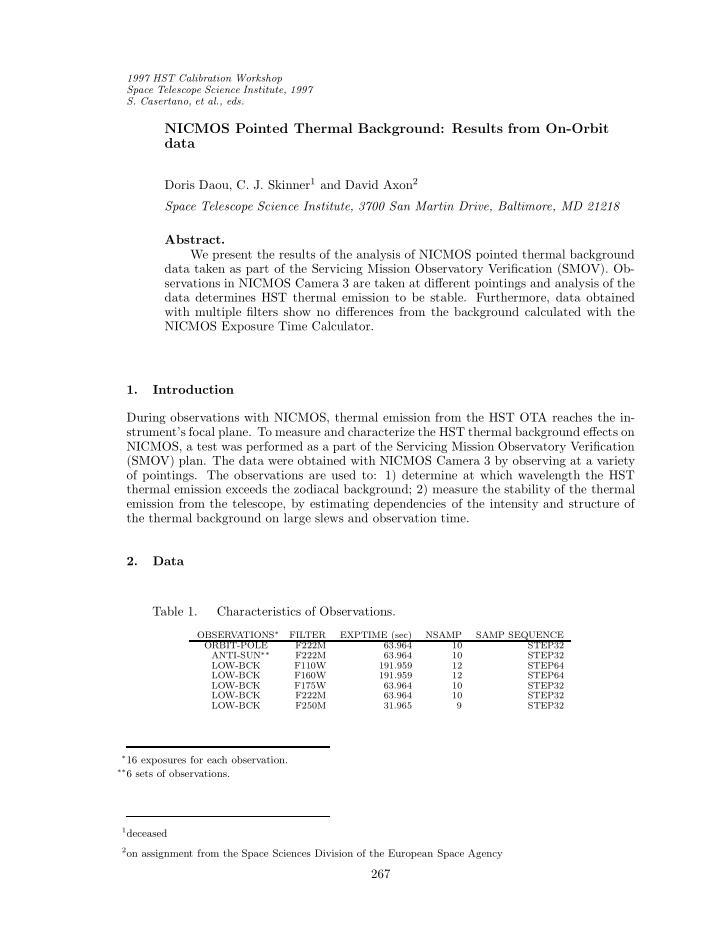



1997 HST Calibration Workshop Space Telescope Science Institute, 1997 S. Casertano, et al., eds. NICMOS Pointed Thermal Background: Results from On-Orbit data Doris Daou, C. J. Skinner 1 and David Axon 2 Space Telescope Science Institute, 3700 San Martin Drive, Baltimore, MD 21218 Abstract. We present the results of the analysis of NICMOS pointed thermal background data taken as part of the Servicing Mission Observatory Verification (SMOV). Ob- servations in NICMOS Camera 3 are taken at different pointings and analysis of the data determines HST thermal emission to be stable. Furthermore, data obtained with multiple filters show no differences from the background calculated with the NICMOS Exposure Time Calculator. 1. Introduction During observations with NICMOS, thermal emission from the HST OTA reaches the in- strument’s focal plane. To measure and characterize the HST thermal background effects on NICMOS, a test was performed as a part of the Servicing Mission Observatory Verification (SMOV) plan. The data were obtained with NICMOS Camera 3 by observing at a variety of pointings. The observations are used to: 1) determine at which wavelength the HST thermal emission exceeds the zodiacal background; 2) measure the stability of the thermal emission from the telescope, by estimating dependencies of the intensity and structure of the thermal background on large slews and observation time. 2. Data Table 1. Characteristics of Observations. OBSERVATIONS ∗ FILTER EXPTIME (sec) NSAMP SAMP SEQUENCE ORBIT-POLE F222M 63.964 10 STEP32 ANTI-SUN ∗∗ F222M 63.964 10 STEP32 LOW-BCK F110W 191.959 12 STEP64 LOW-BCK F160W 191.959 12 STEP64 LOW-BCK F175W 63.964 10 STEP32 LOW-BCK F222M 63.964 10 STEP32 LOW-BCK F250M 31.965 9 STEP32 ∗ 16 exposures for each observation. ∗∗ 6 sets of observations. 1 deceased 2 on assignment from the Space Sciences Division of the European Space Agency 267
268 Daou et al. Figure 1. Example of Thermal Background observations where the bottom row shows the dramatic effects of the thermal emission from the obstructions which cause the vignetting. The images from left to right represent 3 different filters: F110W, F175W and F240M consecutively. 3. Results Table 2. Results from Pointed Observations of 3 different targets as average count-rate. Target (ADU/sec) (e − /pix/sec) ORBIT-POLE 9.068 58.08 ANTI-SUN 9.004 54.02 ZODIACAL BACKGROUND 8.882 53.29 Figure 2. Thermal Background measurement from one Observation set. The Y-axis is the average count-rate (ADU/sec) and the X-axis is the observation time (min). The average count-rate is stable from the first dither pattern exposure to the last. This is true for all data sets of each of the three pointings. Also the average is within the same count-rate of 9 ADU/sec as shown by the first three curves (3 areas on the chip excluding the vignetted parts). The fourth curve is computed over the entire chip including the vignetted area. Each observation set has 16 exposures. Each exposure has an exposure time of 64 seconds. The first 10 exposures of the dither patterns are consecutive and the last 6 begin after 60 minutes.
269 NICMOS Background Figure 3. Thermal Background Measurement from the ANTI-SUN. The Y-axis is the average count-rate (ADU/sec) and the X-axis is the observation time (min). These 6 sets of ANTI-SUN observations were taken consecutively with the F222M filter. Each point represents the combined average count-rate of 16 dither patterns. Again the measurements show no variability over a longer period of observation time. Table 3. Results from Pointed Observations of Zodiacal Background as average count-rate. FILTER Observed Background Observed Background ETC Background (ADU/sec) (e − /pix/sec) e − /pix/sec F110W 0.1288 0.77 0.71 F160W 0.1246 0.75 0.65 F175W 11.35 68.10 79.58 F222M 8.882 53.29 58.28 F240M 57.69 346.14 362.79 Table 4. Comparison with COSTAR Deployment Observations. Filter Before COSTAR After COSTAR Pointed Thermal Bckgrd (ADU/sec) (ADU/sec) (ADU/sec) F110W 0.16 0.16 0.1288 F175W 11.92 12.15 11.35 F240M 61.45 62.57 57.69
270 Daou et al. Figure 4. The thermal background measured after the COSTAR arm deploy- ment is marginally higher than that before deployment. However, the difference is small enough that it could easily be due to a change in the Sun angle of the telescope rather than being a result of COSTAR. The background count-rates observed after COSTAR deployment are very close (within a few percent) to those calculated with the NICMOS Exposure Time Calculator (ETC). They imply, when compared with the pointed thermal background observations,that the background count-rate can change by at least 10% over multiple orbit timescales. However, the data presented here do not give an indication of the length of this variation timescale. The pointed background observations suggest that so long as the pointing remains fixed the thermal background is remarkably stable on the timescales of a few orbits. The ETC appears to give a good estimate of the maximum thermal background likely to be observed, and the minimum appears to be only about 10% lower. 4. Conclusions and Recommendations We have demonstrated that the HST thermal background seems to be independent of large slews, and regardless of the pointing it is estimated to be about 9ADU/sec (58.53 (e − /pic/sec)) in the F222M filter in Camera 3. Also the observed thermal background agrees well the background determined from the Exposure Time Calculator. However, until an analysis of a much larger set of parallel thermal background ob- servations has been completed, we still recommend that observers obtain a background measurement at least once per orbit, as we do not yet know the timescale or causes of background changes which can be as large as 10%.
Recommend
More recommend